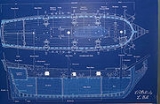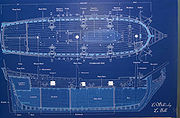
Blueprint
Encyclopedia

Technical drawing
Technical drawing, also known as drafting or draughting, is the act and discipline of composing plans that visually communicate how something functions or has to be constructed.Drafting is the language of industry....
, documenting an architecture
Architecture
Architecture is both the process and product of planning, designing and construction. Architectural works, in the material form of buildings, are often perceived as cultural and political symbols and as works of art...
or an engineering
Engineering
Engineering is the discipline, art, skill and profession of acquiring and applying scientific, mathematical, economic, social, and practical knowledge, in order to design and build structures, machines, devices, systems, materials and processes that safely realize improvements to the lives of...
design. More generally, the term "blueprint" has come to be used to refer to any detailed plan.
Various base materials have been used for blueprints. Paper was a common choice; for more durable prints linen
Linen
Linen is a textile made from the fibers of the flax plant, Linum usitatissimum. Linen is labor-intensive to manufacture, but when it is made into garments, it is valued for its exceptional coolness and freshness in hot weather....
was sometimes used, but with time, the linen prints would shrink slightly. To combat this problem, printing on imitation vellum
Vellum
Vellum is mammal skin prepared for writing or printing on, to produce single pages, scrolls, codices or books. It is generally smooth and durable, although there are great variations depending on preparation, the quality of the skin and the type of animal used...
and, later, polyester film (Mylar) was implemented.
The blueprint process
In 1861 Alphonse Louis Poitevin, a French chemistChemist
A chemist is a scientist trained in the study of chemistry. Chemists study the composition of matter and its properties such as density and acidity. Chemists carefully describe the properties they study in terms of quantities, with detail on the level of molecules and their component atoms...
, found that ferro-gallate in gum
Gum arabic
220px|thumb|right|Acacia gumGum arabic, also known as acacia gum, chaar gund, char goond, or meska, is a natural gum made of hardened sap taken from two species of the acacia tree; Acacia senegal and Acacia seyal...
is light sensitive. Light turns this to an insoluble permanent blue. A coating of this chemical on a paper or other base may be used to reproduce an image from a translucent document.
The ferro-gallate is coated onto a paper from aqueous solution and dried. The coating is yellow. In darkness it is stable for up to three days. It is clamped under glass and a light transmitting document in a daylight exposure frame, which is similar to a picture frame. The frame is put out into daylight requiring a minute or two under a bright sun or about ten times this under an overcast sky. Where ultra-violet light is transmitted the coating converts to a stable blue or black dye. The image can be seen forming, when a strong image is seen the frame is brought indoors and the unconverted coating, under the original image, is washed away. The paper is then dried.
The result is a copy of the original image with the clear background area rendered dark blue and the image reproduced as a white line. The image is stable.
Later other blueprint processes based on photosensitive ferric compounds were used. The best known is probably a process using ammonium ferric citrate and potassium ferricyanide. In this procedure a distinctly blue compound is formed and the process is also known as cyanotype
Cyanotype
Cyanotype is a photographic printing process that gives a cyan-blue print. The process was popular in engineering circles well into the 20th century. The simple and low-cost process enabled them to produce large-scale copies of their work, referred to as blueprints...
. The paper is impregnated with a solution of ammonium ferric citrate and dried. When the paper is illuminated a photoreaction turns the trivalent (ferric) iron into divalent (ferrous) iron. The image is then developed using a solution of potassium ferricyanide forming insoluble ferroferricyanide (Turnball's blue
Prussian blue
Prussian blue is a dark blue pigment with the idealized formula Fe718. Another name for the color Prussian blue is Berlin blue or, in painting, Parisian blue. Turnbull's blue is the same substance but is made from different reagents....
identical to Prussian blue
Prussian blue
Prussian blue is a dark blue pigment with the idealized formula Fe718. Another name for the color Prussian blue is Berlin blue or, in painting, Parisian blue. Turnbull's blue is the same substance but is made from different reagents....
) with the divalent iron. Excess ammonium ferric citrate and potassium ferricyanide are then washed away.
This is a simple process for the reproduction of any light transmitting document. Engineers
Engineer
An engineer is a professional practitioner of engineering, concerned with applying scientific knowledge, mathematics and ingenuity to develop solutions for technical problems. Engineers design materials, structures, machines and systems while considering the limitations imposed by practicality,...
and architects
Architect
An architect is a person trained in the planning, design and oversight of the construction of buildings. To practice architecture means to offer or render services in connection with the design and construction of a building, or group of buildings and the space within the site surrounding the...
drew their designs on cartridge paper
Cartridge paper
Cartridge paper is a high quality type of heavy paper used for illustration and drawing. It was originally used for making weaponry cartridges.- External links :**...
; these were then traced on to tracing paper
Tracing paper
Tracing paper is a type of translucent paper. It is made by immersing uncut and unloaded paper of good quality in sulphuric acid for a few seconds. The acid converts some of the cellulose into amyloid form having a gelatinous and impermeable character. When the treated paper is thoroughly washed...
using indian ink
India ink
India ink is a simple black ink once widely used for writing and printing and now more commonly used for drawing, especially when inking comic books and comic strips.-Composition:...
for reproduction whenever needed.
Replacements for blueprints
Traditional blueprints have largely been replaced by more modern, less expensive printing methods and digital displays. In the early 1940s, cyanotype blueprint began to be supplanted by diazoDiazo
Diazo refers to a type of organic compound called diazo compound that has two linked nitrogen atoms as a terminal functional group. The general formula is R2C=N2. The simplest example of a diazo compound is diazomethane...
prints or whiteprint
Whiteprint
Whiteprint is the commercial terminology to describe document reproduction using the diazo chemical process. It is also known as the blue-line or blue-line process...
s, which have blue lines on a white background; thus these drawings are also called blue-lines or bluelines. Other comparable dye-based prints are known as blacklines.
Diazo prints remain in use in some applications but in many cases have been replaced by xerographic
Xerography
Xerography is a dry photocopying technique invented by Chester Carlson in 1938, for which he was awarded on October 6, 1942. Carlson originally called his invention electrophotography...
print processes similar to standard copy machine technology using toner
Toner
Toner is a powder used in laser printers and photocopiers to form the printed text and images on the paper. In its early form it was simply carbon powder. Then, to improve the quality of the printout, the carbon was melt-mixed with a polymer...
on bond paper
Bond paper
Bond paper is a high quality durable writing paper similar to bank paper but having a weight greater than 50 g/m2. The name comes from it having originally been made for documents such as government bonds. It is now used for letterheads, other stationery and as paper for electronic printers...
. More recently, designs created using Computer-Aided Design
Computer-aided design
Computer-aided design , also known as computer-aided design and drafting , is the use of computer technology for the process of design and design-documentation. Computer Aided Drafting describes the process of drafting with a computer...
techniques may be transferred as a digital file directly to a computer printer
Computer printer
In computing, a printer is a peripheral which produces a text or graphics of documents stored in electronic form, usually on physical print media such as paper or transparencies. Many printers are primarily used as local peripherals, and are attached by a printer cable or, in most new printers, a...
or plotter
Plotter
A plotter is a computer printing device for printing vector graphics. In the past, plotters were widely used in applications such as computer-aided design, though they have generally been replaced with wide-format conventional printers...
; in some applications paper is avoided altogether and work and analysis is done directly from digital displays. Another common modern method of copying is the use of large-format scanners
Image scanner
In computing, an image scanner—often abbreviated to just scanner—is a device that optically scans images, printed text, handwriting, or an object, and converts it to a digital image. Common examples found in offices are variations of the desktop scanner where the document is placed on a glass...
. These digitize an image which can then be printed with a large-format plotter
Plotter
A plotter is a computer printing device for printing vector graphics. In the past, plotters were widely used in applications such as computer-aided design, though they have generally been replaced with wide-format conventional printers...
.
As print and display technology has advanced, the traditional term "blueprint" has continued to be used informally to refer to each type of image.

